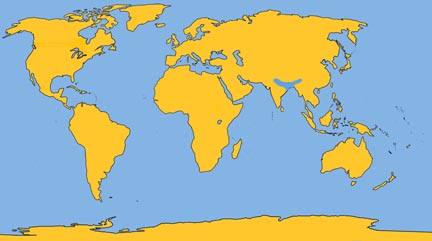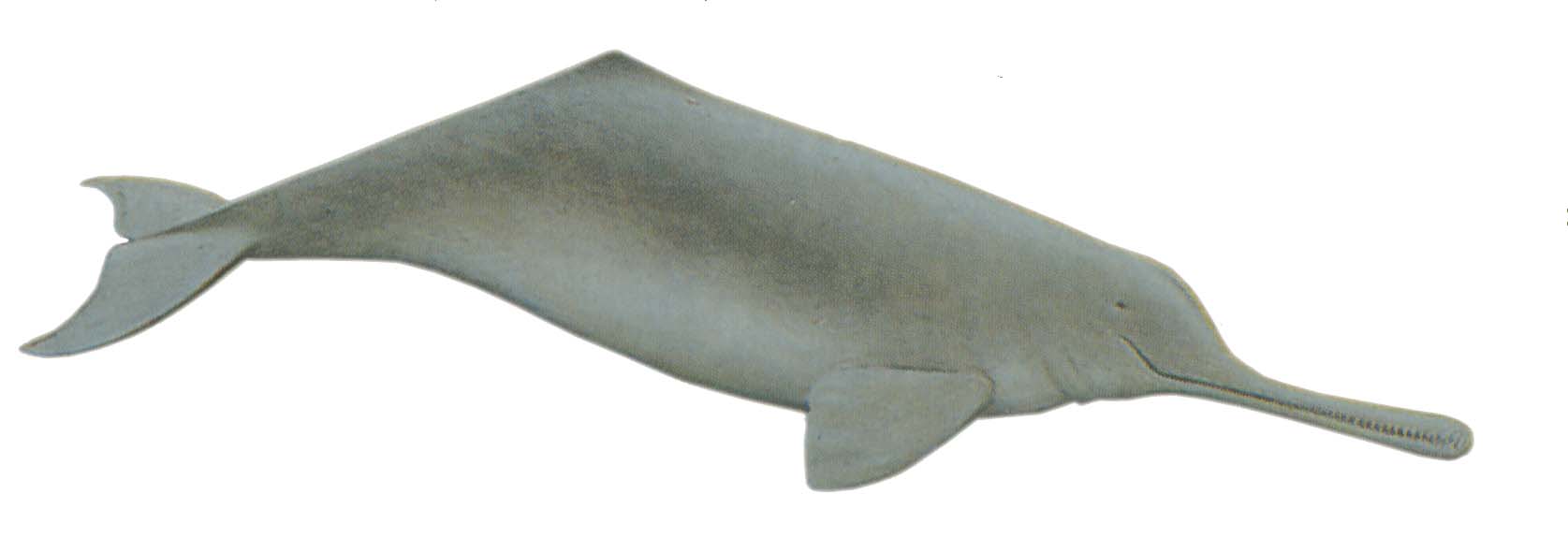Super Family: Platanistoidae
Family: Platanistidae
Genus: Platanista
Species: P. gangetica (Roxburgh, 1801)
Indus River Dolphin
Super Family: Platanistoidae
Family: Platanistidae
Genus: Platanista
Species: P. minor (Owen, 1853)
Taxonomic note: Researchers occasionally use the previously accepted taxonomic labeling Platanista indi, although Platanista minor takes precedence.
The Ganges and Indus River dolphins are highly adapted to their environment. Other than distinguishing between dark and light, their degenerated eyesight plays an insignificant part in the animal’s daily routine. Their bodies are extremely limber and their flippers broad and paddle-shaped in contrast to the more rigid, streamlined flippers of marine dolphins. The neck is flexible, the beak long, and the teeth needle sharp; presumably all of these attributes help the dolphins to capture fish through ability, rather than sheer speed. They have excellent echolocation senses enabling them to navigate their home estuaries. Animals t hat have been kept captive in clear water appear to swim most frequently on their sides.
Although clearly separated geographically, the Ganges and Indus River dolphins are essentially the same.
Physical description: The rostrum is thin and long, averaging 7 in (18 cm), but always longer in females. The blowhole consists of a single lateral slit to the left of the forehead.
Color: A dark gray dorsal region converges to lighter gray flanks and ventral regions.
Fins and Flukes: The dorsal fin consists of a very small rise to the rear of the mid-back region; it falls to follow the dorsal ridge to the well-defined flukes. The flukes are pointed at the tips with a slight median notch. The flippers are large and rounded on the leading edge.
Length and Weight: They reach 6 to 8 ft (1.8 to 2.4 m) and 160 lb (73 kg).
Teeth: About 26 to 37 small, thin teeth appear in each side of the upper and lower jaws, increasing in size from back to front.
Feeding: The diet includes shrimp, catfish, carp, and gobies.
Breathing and Diving: These dolphins breathe at 3 to 30 second intervals, often raising their head out of the water at an angle.
Mating and Breeding: Calves are born at about 28 in (75 cm), possibly between April and July. The gestation period is believed to be 8 to 9 months. Weaning occurs within a year, although solid food can be taken after 2 months. Sexual maturity is attained at 5.5 ft (1.7 m) in males, 5.5 to 6.5 ft (1.7 to 2 m) in females. It has been suggested that females bear calves at intervals of at least 2 years.
Herding: They swim alone or in groups of fewer than 12.
Distribution: Ganges River dolphins are found throughout most of the Ganges, Brahmaputra, and Karnaphuli rivers of India and Bangladesh. The Indus River dolphin is found in the Indus River of Pakistan.
Migration: During summer, Ganges River dolphins travel down the Hoogly River to Calcutta anddown the Pusser River to Chalna.
Ganges River Dolphin
Susu, side-swimming dolphin
Super Family: Platanistoidae
Family: Platanistidae
Genus: Platanista
Species: P. gangetica (Roxburgh, 1801)
Indus River Dolphin
Super Family: Platanistoidae
Family: Platanistidae
Genus: Platanista
Species: P. minor (Owen, 1853)
Taxonomic note: Researchers occasionally use the previously accepted taxonomic labeling Platanista indi, although Platanista minor takes precedence.
The Ganges and Indus River dolphins are highly adapted to their environment. Other than distinguishing between dark and light, their degenerated eyesight plays an insignificant part in the animal’s daily routine. Their bodies are extremely limber and their flippers broad and paddle-shaped in contrast to the more rigid, streamlined flippers of marine dolphins. The neck is flexible, the beak long, and the teeth needle sharp; presumably all of these attributes help the dolphins to capture fish through ability, rather than sheer speed. They have excellent echolocation senses enabling them to navigate their home estuaries. Animals t hat have been kept captive in clear water appear to swim most frequently on their sides.
Although clearly separated geographically, the Ganges and Indus River dolphins are essentially the same.
Physical description: The rostrum is thin and long, averaging 7 in (18 cm), but always longer in females. The blowhole consists of a single lateral slit to the left of the forehead.
Color: A dark gray dorsal region converges to lighter gray flanks and ventral regions.
Fins and Flukes: The dorsal fin consists of a very small rise to the rear of the mid-back region; it falls to follow the dorsal ridge to the well-defined flukes. The flukes are pointed at the tips with a slight median notch. The flippers are large and rounded on the leading edge.
Length and Weight: They reach 6 to 8 ft (1.8 to 2.4 m) and 160 lb (73 kg).
Teeth: About 26 to 37 small, thin teeth appear in each side of the upper and lower jaws, increasing in size from back to front.
Feeding: The diet includes shrimp, catfish, carp, and gobies.
Breathing and Diving: These dolphins breathe at 3 to 30 second intervals, often raising their head out of the water at an angle.
Mating and Breeding: Calves are born at about 28 in (75 cm), possibly between April and July. The gestation period is believed to be 8 to 9 months. Weaning occurs within a year, although solid food can be taken after 2 months. Sexual maturity is attained at 5.5 ft (1.7 m) in males, 5.5 to 6.5 ft (1.7 to 2 m) in females. It has been suggested that females bear calves at intervals of at least 2 years.
Herding: They swim alone or in groups of fewer than 12.
Distribution: Ganges River dolphins are found throughout most of the Ganges, Brahmaputra, and Karnaphuli rivers of India and Bangladesh. The Indus River dolphin is found in the Indus River of Pakistan.
Migration: During summer, Ganges River dolphins travel down the Hoogly River to Calcutta anddown the Pusser River to Chalna.
Natural History Notes: Thee animals have extremely sensitive regions along the leading margin of the flippers that apparently used (along with the long beak) to probe the bottom mud for food, resulting in their nickname of side-swimming dolphin.
Thee animals have extremely sensitive regions along the leading margin of the flippers that apparently used (along with the long beak) to probe the bottom mud for food, resulting in their nickname of side-swimming dolphin.








